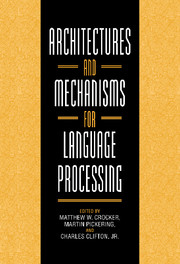Book contents
- Frontmatter
- Contents
- Contributors
- Preface
- 1 Architectures and Mechanisms in Sentence Comprehension
- Part I Frameworks
- Part II Syntactic and Lexical Mechanisms
- Part III Syntax and Semantics
- 9 On the Electrophysiology of Language Comprehension: Implications for the Human Language System
- 10 Parsing and Incremental Understanding During Reading
- 11 Syntactic Attachment and Anaphor Resolution: The Two Sides of Relative Clause Attachment
- 12 Cross-Linguistic Psycholinguistics
- Part IV Interpretation
- Author Index
- Subject Index
9 - On the Electrophysiology of Language Comprehension: Implications for the Human Language System
Published online by Cambridge University Press: 03 October 2009
- Frontmatter
- Contents
- Contributors
- Preface
- 1 Architectures and Mechanisms in Sentence Comprehension
- Part I Frameworks
- Part II Syntactic and Lexical Mechanisms
- Part III Syntax and Semantics
- 9 On the Electrophysiology of Language Comprehension: Implications for the Human Language System
- 10 Parsing and Incremental Understanding During Reading
- 11 Syntactic Attachment and Anaphor Resolution: The Two Sides of Relative Clause Attachment
- 12 Cross-Linguistic Psycholinguistics
- Part IV Interpretation
- Author Index
- Subject Index
Summary
This chapter is on syntactic and semantic processes during on-line language comprehension. We present event-related brain potential (ERP) data from a series of experiments using both written and spoken input, focussing mainly on sentence processing. The data are discussed in terms of the constraints that they impose on the architecture of the human language system, in particular with respect to the separation of syntactic and semantic knowledge bases.
The issue of the separation of different linguistic knowledge sources is an underlying theme in much psycholinguistic research and is especially relevant for a number of contrasting models on parsing. Although linguistic theory has to a large extent postulated distinct representational systems for structure and meaning, psycholinguistic models of the parsing process differ in their assumptions about the separability of syntactic and semantic knowledge bases and of the processing operations that tap into these bases.
One class of models – referred to as garden-path models in the literature – posits a separate syntactic knowledge base. This linguistic knowledge is used for the computation of a separate intermediate level of representation for the syntactic structure of a sentence. Garden-path models claim that the construction of an intermediate syntactic level is a necessary and obligatory step during sentence processing, if not for all structural assignments, then at least for a significant subset of them (e.g., Clifton & Ferreira, 1989; Frazier, 1987; Frazier & Clifton, 1996; Friederici & Mecklinger, 1996; Rayner, Garrod, & Perfetti, 1992).
- Type
- Chapter
- Information
- Architectures and Mechanisms for Language Processing , pp. 213 - 237Publisher: Cambridge University PressPrint publication year: 1999
- 5
- Cited by



